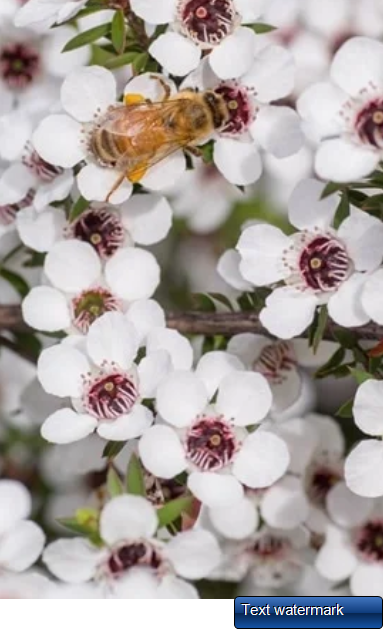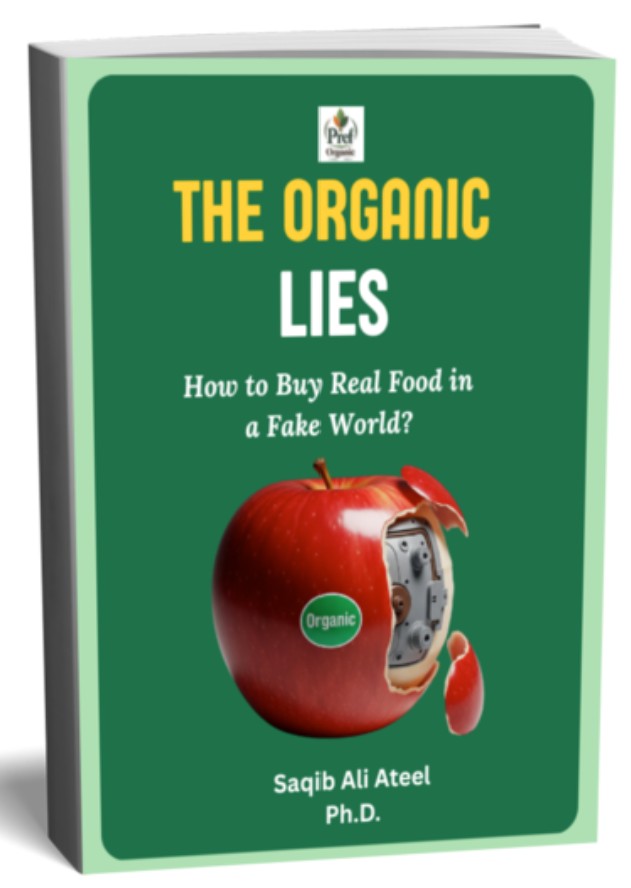Manuka Honey: A Natural Product With Magical Antimicrobial Properties

By: Dr. Salman Ahmad, Ph.D. Agronomy
Salmanahmedbwp@yahoo.com
The main reason for focusing on Manuka honey is to find a safe and natural antibiotic. Manuka is different from regular (local) honey due to its darker color, more viscosity, and density, so difficult to spread over bread slices and top dressing. However, Manuka honey has proven antimicrobial, anticancer, and different wound healing properties. It is recommended as an alternative agent for the treatment of wounds by the United States Federal Drug Administration (US, FDA) in 2007.
Manuka honey is usually rated by following a Unique Manuka Factor (UMF) system, equivalent to the concentration of phenol needed to produce the same antimicrobial activity. Manuka honey UMF ranges from 5 to 20. Higher will be the UMF value of Manuka honey; more will be its antimicrobial activities. Besides dietary use, due to its antimicrobial properties, it is used in several cosmetic products like face cleansers, anti-wrinkle creams, lip balm, eye gel, body lotions, and anti-fungal creams.

Understandably, honey is not a new in the world of medicine. It is being used as medicine since ancient times. It has natural antimicrobial properties due to different compounds like phenolic acids, hydrogen peroxide, and antioxidants. The composition and antimicrobial activities of honey vary from region to region due to climate, geography, honey bees, and plant species.
However, "Manuka honey" has proven its medical properties better than any other one. (Johnston et al., 2018).
Manuka is a shrub native to New Zealand and Australia. It is an ornamental plant bearing white and red pinkish flowers. It is also known as the New Zealand tree plant (locally, its leaves are used for making tea). However, its primary importance is due to the source of nectar for the synthesis of Manuka honey. Manuka honey is a unifloral honey (made from the nectar of Manuka plants only). It is mainly produced in New Zealand and shipped to other countries. At present Manuka honey market is about 314.80 million USD worldwide and expected to be reached 671.5 million USD by the end of 2026.
Bioactive compounds in Manuka Honey
No bacterium has been found yet to resist Manuka honey. It might be due to the presence of many compounds acting separately or synergistically to prevent the development of bacterial resistance against Manuka honey. Manuka honey has a significant amount of Glucose oxidase (involved in Hydrogen Peroxide production having antimicrobial activities), coumaric acid, galangin, pinocembrin, and phenolic acids. All these substances have anti-inflammatory and antioxidant properties. Methylglyoxal (MGO) is the primary antibacterial compound in Manuka honey. MGO in Manuka honey is 100 fold more than in regular honey. The non-Manuka honey contains MGO as 3.1 mg per kilogram, while the MGO concentration in Manuka honey ranged from 38 to 761 mg per kilogram. A minimum of 100 mg per kilogram of MGO contents is necessary for effective antimicrobial activities.
Antibacterial effects of Manuka Honey
Manuka honey has significant antibacterial properties. It has proved beneficial in reducing dental plaque and gingivitis (the disease causes gum infection). In an experiment, Manuka honey was used as an oral treatment in 30 subjects for 21 days. Results revealed a significant reduction in plaque, gum bleeding sites, and gum inflammation. In another study, Manuka honey was compared with chlorhexidine gluconate mouth wash (an antiseptic chemical effective against gram-positive and gram-negative bacteria) and xylitol chewing gum (used to prevent tooth plaque and cavities). Results showed significant effects of both Manuka honey and chlorhexidine gluconate on reducing tooth plaque development than xylitol chewing gum. Manuka honey treatment also inhibited the growth of multispecies biofilm within dental plaque mainly due to the presence of hydrogen peroxide (Nayak et al., 2010).
In Hidradenitis suppurativa (skin disease), topical dressing of Manuka honey minimizes the chances of bacterial infection by reducing the healing time. Manuka honey suppresses the infection of Staphylococcus aureus by disturbing the cell division mechanism of bacterium cells. Bacteria responsible for inflammation of the mucous membrane (Rhinosinusitis) are resistant to the commonly used antibiotic "methicillin." Application of Manuka honey on affected mucous membrane breaks the bacterial biofilm layer of these resistant bacteria by bacterial cell lysis and damaging DNA (Cooper et al., 2001; Henriques et al., 2010; Kilty et al., 2011).
Manuka honey is more effective in destroying the biofilms of gut pathogens and multi- antibacterial resistant bacteria due to its multi-phytochemicals, especially MGO and hydrogen peroxide contents. It has proven effective against highly antibiotic-resistant pathogens called "superbugs." Moreover, Manuka in combination with commonly used antibiotics not only decrease the dose of synthetic antibiotic but also increase the efficacy of antibiotics and most important break the development of resistance in bacteria against antibiotics. For example, the combination of oxacillin with Manuka honey inhibits bacteria's growth and suppresses the genes responsible for resistant development. Manuka honey has been synergistically reported with antibiotics like tetracycline, imipenem, mupirocin, and rifampicin (Carter et al., 2016).
Antiviral and ulcer wound healing properties of Manuka honey
When treated with different concentrations of Manuka honey, human cells containing Varicella zoster (a virus that causes chickenpox) showed significant anti-viral effects.
Wound infections due to infection mediators delay the healing process.
Manuka honey has been reported effective in the healing of the ulcer, diabetic wounds, acne, burns and eczema by decreasing wound pH, which hastens the process of wound healing (Gethin et al., 2008).
In an experiment, Manuka honey was used in wound therapy of sloughy venous wound ulcers and showed remarkable effects on wound healing by promoting autografting of skin on wounds. Similarly, in a study, the inclusion of Manuka honey in ulcer treatment minimizes bacterial growth on the injury by creating an antimicrobial environment.
In the healing of neuropathic diabetic foot ulcers, Manuka honey-based dressing healed the ulcer in 31 days with 97% healing percentage than 43 healing days in conventional sauce with 90% healing percentage (Kamaratos et al., 2014). In a laboratory experiment, tumors treated with Manuka honey showed a 33% decrease in tumor growth. In comparison, a combination of Manuka honey with paclitaxel (a chemical used for tumor treatment) markedly (61%) inhibited tumor growth in animals.
Anti-inflammatory/ antioxidant effects of Manuka honey
Under stress conditions, reactive oxygen species (ROS) concentration increases in cells that disturb cells' normal functioning by deteriorating different cell organelles. Manuka honey has more concentration of antioxidants and phenolic compounds when compared with other types of honey from various locations like Algeria, Germany, Scotland, and Saudi Arabia (Schneider et al., 2013). The anti-inflammatory property of Manuka honey significantly reduces the damage caused by ROS, thus prevent necrosis (cell death). Superoxide radicals are scavenged by methyl syringate, pinocembrin, and gallic acid. Reduction in the concentration of neutrophil superoxide was also reported by using Manuka honey. However, further research is needed to fully understand the anti-inflammatory/ antioxidant properties of Manuka honey (Patel and Cichello, 2013).
Mode of action
The mechanism of antimicrobial action of Manuka honey is not fully understood. However, some possible ways are described here. In a recent study, Manuka honey is reported to be effective in disturbing the quorum sensing (term describes the bacterial communication by signals which is a critical factor in the development of antibiotic-resistant biofilms and favor the production of antibiotic-resistant cells) mainly due to its sugar contents and thus decrease the pathogenicity/virulence of pathogens (Wang et al., 2012). Further, Pathogens are more active and increase pathogenicity under alkaline conditions. Manuka honey has acidic pH (3.5 to 4.5) due to many organic acids, which lowers the alkalinity around the wound and promotes healing. Manuka honey dressings increase fibroblast activity (cells involved in wound healing) and oxygen release, which hasten the healing process. When used superficially, Manuka honey dries the mucus of the injured skin by absorbing wound exudates (due to viscosity and osmotic pull) and creates unfavorable conditions for bacterial growth. Moreover, many antimicrobial compounds, especially MGO, even at shallow concentrations, are lethal for microbial growth by disrupting cell division and destroying microbial DNA (Carter et al.,2016).
Future Thrust
• At present, Manuka honey production is mainly confined to New Zealand and some parts of Australia. So, further research is needed on whether geographical location affects the composition of honey.
• The antimicrobial role of Manuka is not fully understood, and more research is needed to explore it further.
• Manuka honey dose for sugar patients and its suitability for people sensitive to pollen allergies should also be investigated.
Conclusion
Due to side effects and increasing resistance in pathogens against synthetic antibiotics, there is a dire need to find natural alternative antimicrobial agents. Manuka honey has proven antibacterial, anti-fungal, anti-inflammatory/antioxidant, and anti-resistance development properties against a wide range of pathogens. However, due to its limited availability and some new features, more research is needed to explore its bioactive compounds and their role in treating different diseases to be produced and made available at a larger scale for the well-being of humankind.
References
Carter, D. A., Blair, S. E., Cokcetin, N. N., Bouzo, D., Brooks, P., Schothauer, R., & Harry, E. J. (2016). Therapeutic manuka honey: no longer so alternative. Frontiers in microbiology, 7, 569.
Cooper, R., Molan, P., Krishnamoorthy, L., & Harding, K. (2001). Manuka honey used to heal a recalcitrant surgical wound. European Journal of Clinical Microbiology and Infectious Diseases, 20(10), 758.
Gethin, G. T., Cowman, S., & Conroy, R. M. (2008). The impact of Manuka honey dressings on the surface pH of chronic wounds. International Wound Journal, 5(2), 185-194.
Henriques, A. F., Jenkins, R. E., Burton, N. F., & Cooper, R. A. (2010). The intracellular effects of manuka honey on Staphylococcus aureus. European journal of clinical microbiology & infectious diseases, 29(1), 45.
Johnston, M., McBride, M., Dahiya, D., Owusu-Apenten, R., & Nigam, P. S. (2018). Antibacterial activity of Manuka honey and its components: An overview. AIMS microbiology, 4(4), 655.
Kamaratos, A. V., Tzirogiannis, K. N., Iraklianou, S. A., Panoutsopoulos, G. I., Kanellos, I. E., & Melidonis, A. I. (2014). Manuka honey‐impregnated dressings in the treatment of neuropathic diabetic foot ulcers. International wound journal, 11(3), 259-263.
Kilty, S. J., Duval, M., Chan, F. T., Ferris, W., & Slinger, R. (2011). Methylglyoxal:(active agent of manuka honey) in vitroactivity against bacterial biofilms. Int. Forum Allergy Rhinol. 1: 348–350.
Nayak, P. A., Nayak, U. A., & Mythili, R. (2010). Effect of Manuka honey, chlorhexidine gluconate, and xylitol on the clinical levels of dental plaque. Contemporary clinical dentistry, 1(4), 214.
Patel, S., & Cichello, S. (2013). Manuka honey: an emerging natural food with medicinal use. Natural products and bioprospecting, 3(4), 121-128.
Schneider, M., Coyle, S., Warnock, M., Gow, I., & Fyfe, L. (2013). Antimicrobial activity and composition of Manuka and Portobello Honey. Phytotherapy Research, 27(8), 1162-1168.
Wang, R., Starkey, M., Hazan, R., & Rahme, L. (2012). Honey's ability to counter bacterial infections arises from both bactericidal compounds and QS inhibition. Frontiers in microbiology, 3, 144.
- Home
- Organic Food
- Manuka Honey
